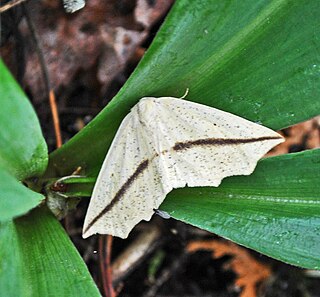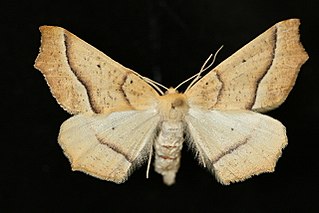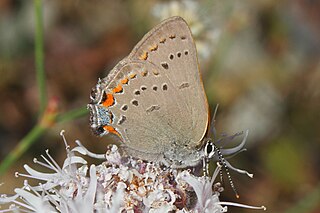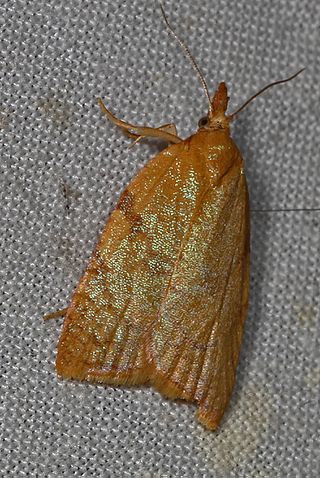
Tetracis is a genus of moths in the family Geometridae erected by Achille Guenée in 1858.

Aseptis fumosa is a moth of the family Noctuidae first described by Augustus Radcliffe Grote in 1879. It is widespread in western North America and is known from western Canada, Washington, Nebraska, Colorado, Utah, Arizona, Nevada and California. It occurs in a variety of diverse habitats including coast chaparral, dry conifer forest, and shrub steppe.

Tetracis crocallata is a moth of the family Geometridae first described by Achille Guenée in 1858. It is found in North America from Nova Scotia, New Brunswick, southern Manitoba and southern Saskatchewan to Alberta, south to northern Florida, west to Kansas, Nebraska, North Dakota and extreme eastern Texas.
Tetracis australis is a moth of the family Geometridae. It is found from the coastal southern regions of the U.S. state of California from Monterey County south to Los Encinas, San Pedro Martir, Baja California, Mexico, at altitudes from near sea level to 2,135 meters.

Tetracis cachexiata, the white slant-line or white slaut, is a moth of the family Geometridae. The species was first described by Achille Guenée in 1858. It is found in North America from Nova Scotia to central British Columbia, south to northern Florida and west to Montana and northern Colorado.

Tetracis cervinaria is a moth of the family Geometridae first described by Alpheus Spring Packard in 1871. It is found in North America from British Columbia south to Kern County, California and eastward to western Montana, south-eastern Idaho, Carbon County, Wyoming and Larimer County, Colorado. It is found at elevations of 790 to 2,375 meters.
Tetracis fuscata is a moth of the family Geometridae first described by George Duryea Hulst in 1898. It is only known from the US states of Colorado and Wyoming.

Tetracis pallulata is a moth of the family Geometridae first described by George Duryea Hulst in 1887. It is found in western North America from southern California north to British Columbia, east to Idaho and western Montana from near sea level to 2,200 meters.
Tetracis mosesiani is a moth of the family Geometridae. It is found coastal California from near sea level to 915 meters.
Tetracis jubararia is a moth of the family Geometridae. It is found in North America.
Tetracis montanaria is a moth of the family Geometridae. It is only known from south-eastern Arizona. It is found in aspen-coniferous forests on altitudes between 2,440 and 2,715 meters.
Tetracis barnesii is a moth of the family Geometridae. It is found from the high-desert riparian canyons in Colorado and Utah to the dry coniferous forest in Oregon on altitudes between 1,555 and 1,905 meters.
Tetracis formosa is a moth of the family Geometridae first described by George Duryea Hulst in 1896. It is found in North America from Colorado, eastern Utah and eastern Wyoming west to California and north to southern British Columbia and southern Alberta at elevations between 870 and 2,320 meters.
Tetracis pallidata is a moth of the family Geometridae first described by Clifford D. Ferris in 2009. It is found in British Columbia, Idaho and Washington.

Quercus mohriana, commonly known as the Mohr oak, shin oak or scrub oak, is a North American evergreen shrub or small tree in the white oak group and is native to the south-central United States and north-central Mexico. The species epithet mohriana honors the pharmacist and botanist Charles Mohr of Alabama.

Satyrium californica, the California hairstreak, is a butterfly of the family Lycaenidae. It is found from British Columbia south to southern California and east to Colorado.

Iridopsis clivinaria, the mountain mahogany looper moth, is a moth of the family Geometridae. It is found from British Columbia south to California and east to Idaho, Colorado and Arizona.

Garrya wrightii is a species of flowering plant in the family Garryaceae known by the common names Wright's silktassel, quinine-bush, coffee berry, bearberry, feverbush, and grayleaf dogwood.

Sparganothis senecionana is a species of moth of the family Tortricidae. It is found in western North America, from British Columbia to Mexico and east to Colorado.
Chionodes occidentella is a moth in the family Gelechiidae. It is found in North America, where it has been recorded from British Columbia to California and Arizona.











